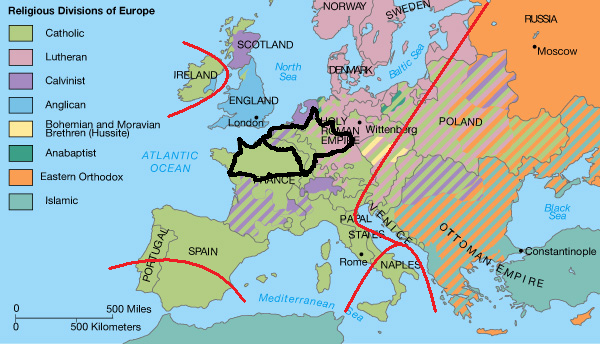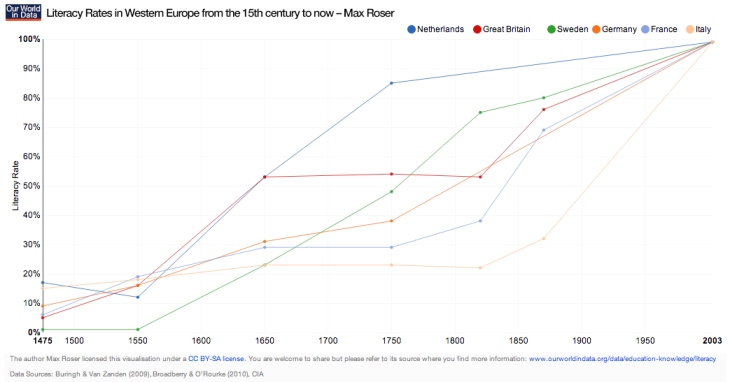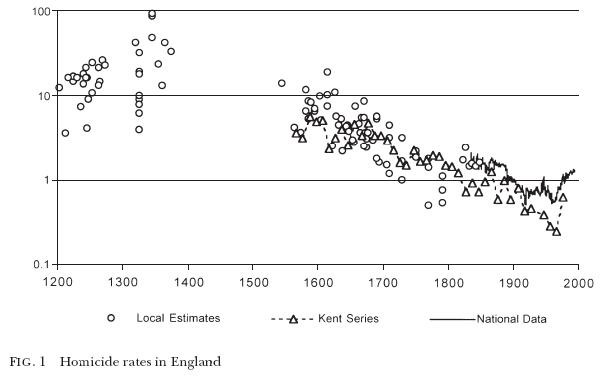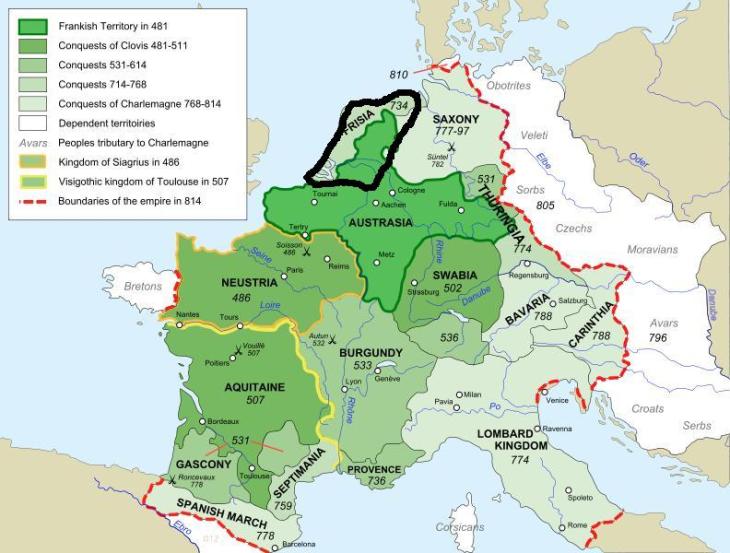*update below*
i thought i’d do a big summary post on the hajnal line, just to have everything in once place. (^_^) sorry, there is no tl;dr, so go get yourself a cup of coffee. i’ll wait here.
back already?! ok…
so, here is the hajnal line:
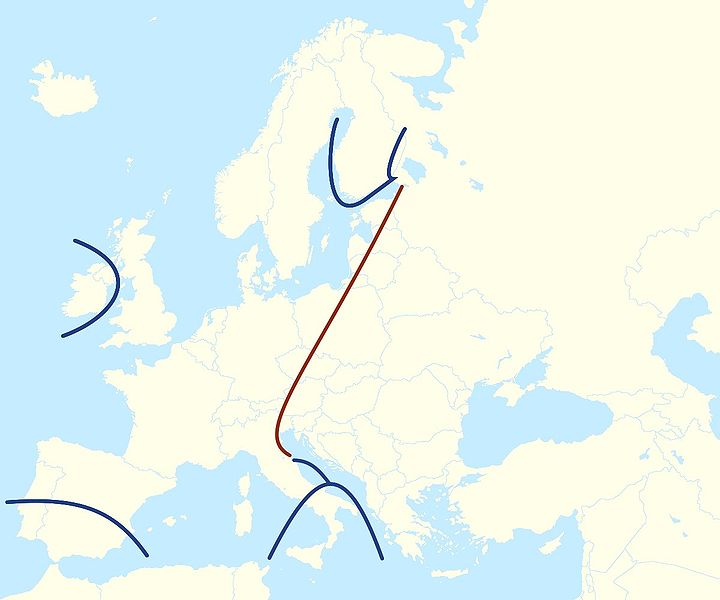
from wikipedia: “The line in red is Hajnal’s. The dark blue lines show areas of high nuptiality west of the Hajnal line.”
obviously this is a schematic map. the true hajnal line should, no doubt, be all squiggly. i also suspect that a few other areas in western europe ought to be “outside” the hajnal line as well: highland scotland most definitely and galicia in spain possibly, although that latter one is more of a guess. possibly brittany, too, while i’m at it. oh, and it also appears as though the hajnal line should run through finland somewhere, separating the east from the west, with the eastern part being INSIDE the line. more on that…someday. (*^_^*)
anyway, more from wikipedia: “The Hajnal line is a border that links Saint Petersburg, Russia and Trieste, Italy. In 1965, John Hajnal discovered it divides Europe into two areas characterized by a different levels of nuptiality. To the west of the line, marriage rates and thus fertility were comparatively low and a significant minority of women married late or remained single; to the east of the line and in the Mediterranean and select pockets of Northwestern Europe, early marriage was the norm and high fertility was countered by high mortality.
“West of this line, the average age of marriage for women was 23 or more, men 26, spouses were relatively close in age, a substantial number of women married for the first time in their thirties and forties, and 10% to 20% of adults never married. East of the line, the mean age of both sexes at marriage was earlier, spousal age disparity was greater and marriage more nearly universal. Subsequent research has amply confirmed Hajnal’s continental divide, and what has come to be known as the ‘Western European marriage pattern’, although historical demographers have also noted that there are significant variations within the region; to the west of the line, about half of all women aged 15 to 50 years of age were married while the other half were widows or spinsters; to the east of the line, about seventy percent of women in that age bracket were married while the other thirty percent were widows or nuns….
“The region’s late marriage pattern has received considerable scholarly attention in part because it appears to be unique; it has not been found in any other part of the world prior to the Twentieth Century. The origins of the late marriage system are a matter of conjecture prior to the 16th Century when the demographic evidence from family reconstitution studies makes the prevalence of the pattern clear; while evidence is scanty, most English couples seemed to marry for the first time in their early twenties before the Black Death and afterward, when economic conditions were better, often married in their late teens.”
so, the two big things that hajnal discovered: late marriage common in western europe plus a lot of individuals never marrying in western europe.
hajnal’s original article on his line — “European marriage pattern in historical perspective” — was published in 1965 in Population in History: Essays in Historical Demography.
_____
as if that weren’t interesting enough on its own, there seems to be a lot of other things connected — or somehow related — to the hajnal line. for instance, the distribution of nuclear families in europe. here’s a map of emmanuel todd‘s traditional family systems in europe — the absolute, egalitarian, and stem families (yellow, blue, and green on the map) are all types of nuclear or small-sized families (the stem family is the immediate family plus one set of grandparents, so it has slightly more members than a pure nuclear family). as you can see, small families (nuclear and stem families) occur most frequently to the west of or “inside” the hajnal line, community or extended families more frequently outside of it (h/t m.g. for the map! — hajnal line added by me):

the distribution of average national iqs also seems to be related to the hajnal line — in general, higher average national iqs are found inside the hajnal line rather than outside of it (h/t jayman for this map! — hajnal line added by me):

perhaps thanks to the distribution of average iqs (although i don’t think that iq is the whole story), maybe we shouldn’t be surprised to find the highest concentrations of human accomplishment in europe distributed like this, i.e. falling mostly within the hajnal line (h/t charles murray for the map! — hajnal line added by me):
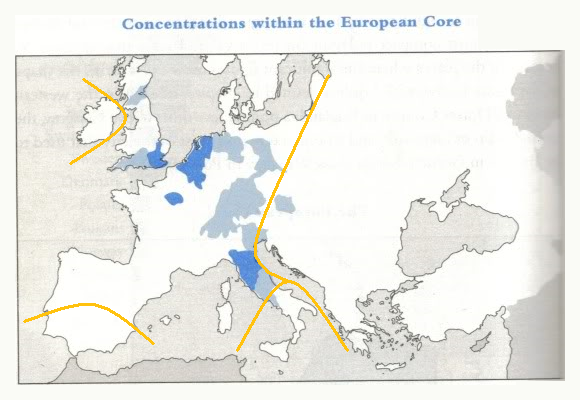
nations west of the hajnal line tend to be stronger in democratic tendencies than nations east of the line. here’s a map of the economist’s intelligence [sic] unit’s 2012 democracy index results for europe — with hajnal line added (by me). the darker the green, the more democracy:

the populations west of the hajnal line also appear to be more civic-minded than those to the east of it. civicness here is determined using robert putnam’s technique of looking at participation rates in voluntary associations. the data below are drawn from the world values survey — see more details in this post — and this one, too! (sorry, i haven’t got a map for these data, so you’ll have to make do with a table. the data for each individual country can be found in this post. the eastern european countries — circled in red — are all fully or partially east of the hajnal line. the remainder are not, although remember that southern italy and southern spain — two of the “southern europeans” here — are. note also that “anglos” includes the u.s., canada, australia, etc. — for great britain’s scores, see this post. click on table for LARGER view.)

and perceived corruption is generally lower inside the hajnal line than outside. here is a map based on transparency international’s corruptions perceptions index scores for europe in 2012 (hajnal line added by me):

populations inside the hajnal also tend to score higher on individualism on hofstede’s individualism versus collectivism (IDV) dimension, while those outside the hajnal line are more collectivistic (see this post). here is a map of these scores that i swiped off the internet. i have a few reservations about this map which i discussed in the previous post — the raw scores are also listed in that post (hajnal line added by me):
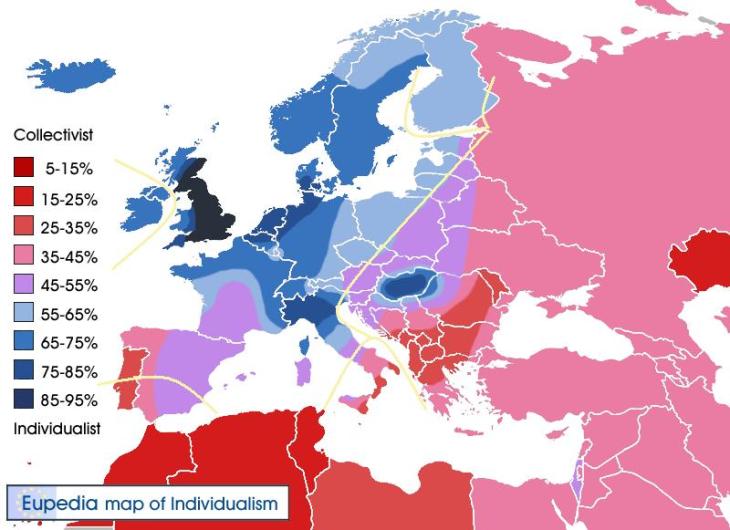
and here’s a map taken from steven pinker’s Better Angels of the geography of homicide in late nineteenth century europe (hajnal line added by me). the homicide rates were significantly lower inside the hajnal line than outside of it in the late nineteenth century (more on this later in the post):
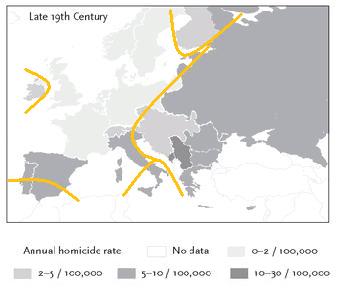 _____
_____
so, to sum up — INSIDE (or to the west of) the hajnal line we find:
– late marriage and 10-20% of adults never marrying
– small families, either nuclear or stem
– higher average iqs than outside the line
– the highest concentrations of human accomplishment in europe
– more democracy
– greater civic-mindedness or orientation towards the commonweal
– generally low perceived corruption
– high individualism
– and low homicide rates in the 19th century
why?
at first glance, the most obvious explanation would seem to be simply that these are all germanic populations to some extent or another. we’ve got the franks and co. in france and the low countries, the visigoths in northern spain, the langobards (and others) in northern italy, the swiss, the austrians, the scandinavians, and the peoples who became “the germans” in germany after they reconquered those areas during the ostsiedlung. and maybe that’s it. maybe that’s the whole story. i don’t think so, though, although it’s likely a part of the story (perhaps even a big part, i dunno).
why don’t i think that’s the whole story?
well, first of all, despite what you might’ve heard from tacitus, the pre-christian germanics did not marry late. going by the archaeological evidence (i.e. the types of grave goods found associated with girls aged around twelve to fourteen), it appears that pre-christian germanic women married young — probably right around the time they hit puberty. not sure about the men, but the case of the females indicates that hajnal’s line does not extend back into pre-christian times. odds are, too, that, like in most other societies in the world, the majority married, but i have no evidence for that either way.
additionally, the nuclear family was not the primary foundational building block of pre-christian germanic societies. while the pre-christian germanics do seem to have had residential nuclear families, it was the extended family — the kindred — that was of utmost importance both socially and legally to the germanic tribes (see for example this post). (this, btw, is similar to sicilians and other southern italians today, as well as to the greeks — these groups have residential nuclear families, but the extended family is very, *very* important in those populations. this is something that, i think, emmanuel todd overlooked. planning to work up a post on the topic…one of these days. (^_^) )
there are also no indications that the pre-christian germanics were particularly bright. they didn’t build any aqueducts anyway.
also — and i know this will get some of you riled up — the pre-christian germanics weren’t any more democratic than any other clannish populations on the planet were in the past or are today. yes, yes, i know, i know — the things! yes. i know. you’ll have to trust me on this for now — those things are not very good indicators of the presence of democracy. at least not democracy as we know it (or like to think we know it). i will come back to this in another post, i promise! for now, please just trust me on this. (for a couple of hints on what i’ll be getting at, you can have a look at this post and the first section of this post where i mention democracy in medieval iceland.)
it’s also unlikely that the pre-christian germanics were particularly oriented towards the broader commonweal either. pre-christian germanic society was, as i said, structured around the extended family, or the kindreds, and blood-feuds between kindreds were common (and legal). in any other society that i know of which is structured like that — like afghani society today, for instance (although there they have even tighter clans — the germanic kindreds had a looser configuration) — the members are not interested in the common good. they are interested in their extended family’s good. that’s it. in such societies, too, individualism usually runs second to collectivism — again, that’s a collective attitude toward the extended family, not the broader society. not sure how much individualism there was in pre-christian germanic society. still need to find that out (if possible).
finally, the violence/homicide rates in pre-christian germanic societies were undoubtedly high. the omnipresent blood-feuds — not to mention all of the whopping great germanic swords and the seaxes — indicate that this was probably the case.
_____
the historic evidence for the existence of the hajnal line goes back to the 1500s, but no one’s quite sure when the pattern first emerged. the only thing that’s clear is that it was sometime between the introduction of christianity to the germanics in northern europe (which started in something like the 400s) and the 1500s.
two of the biggest changes to this area of europe beginning in the early medieval period were: the introduction of new mating patterns thanks to the catholic church and the introduction of manorialism. these two elements of medieval european society were present in the areas inside the hajnal line and were absent to various degrees in the areas outside the line. in fact, hajnal’s line lies exactly at the limits of western christendom and the (bipartite) manor system in eastern europe (and southern italy and spain and ireland, etc.). this is not my idea, but something i picked up from the historian michael mitterauer’s book Why Europe? [pgs. 45-45]:
“The most significant expansion of the model agricultural system [manorialism] in the Frankish heartland between the Seine and the Rhine took place toward the east. Its diffusion embraced almost the whole of central Europe and large parts of eastern Europe….. This great colonizing process, which transmitted Frankish agricultural structures and their accompanying forms of lordship, took off at the latest around the middle of the eighth century. Frankish majordomos or kings from the Carolingian house introduced manorial estates (*Villikation*) and the hide system (*Hufenverfassung*) throughout the royal estates east of the Rhine as well…. The eastern limit of the Carolingian Empire was for a long time an important dividing line between the expanding Frankish agricultural system and eastern European agricultural structures. When the push toward colonization continued with more force in the High Middle Ages, newer models of *Rentengrundherrschaft* predominated — but they were still founded on the hide system. This pattern was consequently established over a wide area: in the Baltic, in large parts of Poland, in Bohemia, Moravia and parts of Slovakis, in western Hungary, and in Slovenia.”
but note that the manor system was introduced into these eastern regions much later than it had been in the west. more from mitterauer:
“Colonization established a line streching roughly from St. Petersburg to Trieste. We will come across this line again when studying European family systems and their diffusion. The sixteenth century witnessed the last great attempt to establish the hide system throughout an eastern European region when King Sigismund II of Poland tried it in the Lithuanian part of his empire in what is modern-day Belarus. The eastward expansion of Frankish agrarian reform therefore spanned at least eight centuries.”
mitterauer also discusses the hows and whys of the absence of manorialism in southern italy, spain, ireland, etc. — in other words, all of the populations which are today outside the hajnal line [pg. 54]:
“Over against this ‘core Europe’ was a ‘peripheral Europe’ that did not acquire these structures until a relatively later date — or not at all. Here we can list Ireland, Wales, and Scotland in the West; the area of eastern Europe beyond the Trieste-St. Petersburg line that was unaffected by the colonization of the East; the entire Balkan region; southern Italy, which was formerly Byzantine, along with the southern part of the Iberian Peninsula that was under Moorish rule for so long a time. The political, economic, and social evolution of many regions in ‘peripheral Europe’ took a different turn because of their clinging to other, traditional agricultural systems.”
there’s no map in Why Europe? showing the areas of europe that were “manorialized” according to mitterauer, so i gave a shot at creating one based on mitterauer’s descriptions in the book (frisia was never manorialized, btw):

yup! looks pretty much just like the hajnal line.
manorialism is important for at least two reasons — and probably many more that i haven’t thought about. firstly, the whole system was based on nuclear families. in the bipartite manor system, peasants or serfs or whomever (depending on time and place in western europe) lived on and managed their own farms (let out to them by the manor owner) and also worked on the manor or paid rent to the manor. extended families very much did not fit into the manor system as it operated in western europe (there was a different development in eastern europe where extended families were very much part of the package). so manorialism — at least western manorialism — “pushed” for the nuclear family. as early as the 800s in northwestern france, families that lived and worked on manors were very small, most often being only two generations (parents and children) and occasionally including a grandparent.
the second reason manorialism was so important was because this was the vehicle via which the ecclesiastical and secular laws against cousin marriage could be enforced. as greying wanderer commented the other day:
“Not only was the land owned by the Lord of the Manor rather than by the village commune as it was elsewhere the manor with its central manor house and church was a model of combined civil and religious authority. Those villagers who wanted to get ahead with their own little plot of land had to be respectable and that meant if married it had to abide by the church’s rules.”
exactly!
so, because the populations in peripheral europe missed out on manorialism, they also missed out on the “push” for nuclear families and the more stringent enforcement of the cousin marriage bans.
however, mitterauer makes the point that it appears as though conversion to christianity was needed first before manorialism could be successfully introduced [pg. 77]:
“The introduction of Christianity always preceded the introduction of the hide system throughout the entire colonization in the East — often by only a slight difference in time, but occasionally centuries earlier. The time sequence was never reversed, anywhere. The western agrarian system at all times found a state of affairs where Christian conversion had either relaxed or weakened older patrilineal patterns. This process had already paved the way for the transition to a bilateral system of kinship and the conjugal family.”
medieval christianity weakened the old patrilineal clannish (or kindred-based) systems because it insisted upon the avoidance of cousin marriage which reduced the genetic ties between extended family members and set the stage for the selection of very different behavioral patterns in parts of northwestern europe — “core” europe. orthodox christianity in eastern europe also banned close cousin marriage, but this came later in that area of the world (since they adopted christianity later), and enforcement was not as firm as in the west — the secular regulations on marriage in medieval russia, for instance, flip-flopped several times and do not seem to have backed up the orthodox church’s canon laws as consistently as secular authorities had tended to do in the west (see here and here for example). and, again, the manor system was a very late arrival in eastern europe, and in many places it was not a bipartite system based upon nuclear families. the eastern european extended family networks were incorporated into the manor system which developed there, because the extended family had never been broken apart in the east, since the cousin marriage bans were adopted at a later point in time and were not as strongly enforced.
_____
the long-term outbreeding of northwestern europeans, which began in the early medieval period, resulted in a new social environment for these populations. gone were the clans and kindreds, gone were the extended families, gone was the close genetic relatedness between extended family members (in inbreeding societies, the probability that first cousins share genes [alleles] in common can be nearly double of that in outbreeding societies). this was all replaced by a society based upon individuals and their nuclear families — and each of these “new europeans” were more unique genetic individuals than those in more inbred societies who share more genes in common with their relatives.
with a new environment — in this case a new social environment — comes new selection pressures. the question to ask with regard to these big changes in medieval western europe is who succeeded in this brave new world? what sort of individuals managed to do well in life and reproduce successfully? the most. what sorts of personality traits did “the fittest” have? intelligence levels? behavioral patterns? what sorts of genes got selected for in this new environment?
the new patterns of genetic relatedness between individuals would’ve (i think) changed the speed at which alleles for different sorts of behavioral traits — especially those related to altruistic behaviors — might’ve been selected (see here for example). in a long-term outbreeding society, it might pay to be altruistic towards two brothers or eight cousins, but if you’re from a long-term inbreeding society, you might only need to be altruistic towards four or five cousins to achieve the same genetic payoff. and, if you actually are altruistic towards the full number of eight cousins, whatever “genes for altruism” that you and your cousins carry will be selected for faster than in an outbreeding society, since you all carry more copies of them than outbreeding individuals do.
in the societies outside the hajnal line, then, where the populations experienced, to differing degrees, more long-term inbreeding than those inside the hajnal line, people continue to favor their family members (or those whom they consider “one of theirs”) more. such behaviors continued to pay — genetically speaking — for longer, so these “altruistic” behaviors never got weeded out of those populations — or not so much anyway. therefore, the individuals in populations outside of the hajnal line tend to exhibit innate behaviors that favor themselves as members of extended families as opposed to favoring themselves as individual players in a broader community. this common thread of favoring the family (and/or intimate allies) can, i think, explain the common characteristics of societies that are outside the hajnal line: being comprised of large, tightly-knit extended families; having low average iqs (because individuals don’t have to fend for themselves as much?); having less democracy, less civic-mindedness, and greater amounts of corruption (including nepotism) since everyone is more oriented towards their own than to unrelated strangers; and having higher homicide rates.
on the other hand, what sorts of traits would’ve been selected for in individuals in long-term outbreeding societies where there would’ve been less of a genetic payoff in being altruistic towards extended family? i think you would (or could) have greater selection for individuals having behavioral traits which drive them to contribute more to the broader community. since the payoff for aiding extended family was no longer so great in “core” europe after many generations of outbreeding (i.e. avoiding close cousin marriage), it might’ve begun to pay equally well — or well enough — to aid non-family members (rather than extended family members) — to cooperate with them in the hopes of receiving aid back. in a society where one doesn’t have an extended family to fall back on, it might be very useful to possess traits which enable the successful collaboration with non-family — being trusting and trustworty, for instance. a society of such individuals might very likely: be comprised of small-sized families; have a higher average iq since individuals had to fend for themselves more; have more (liberal) democracy, more civic-mindedness, and less corruption since everyone would be more oriented towards the commonweal and not towards their extended family members. homicide rates would be low, too.
_____
if this hajnal line divide between western and eastern europe sounds a lot like huntington’s civilizational divide which steve sailer posted about the other day, that’s because it probably is very much the same divide. but the divide is not just between the western and eastern churches, it’s a divide between a long history of different mating patterns and family types in the west versus the east — much more outbreeding (i.e. the avoidance of close cousin marriage) for a longer period of time, and the development of and emphasis upon small families as opposed to large extended families, in the west and not in the east — and the divergent selection pressures that the two european civilizations underwent thanks to the differing mating patterns/family types. from huntington:
“The most significant dividing line in Europe, as William Wallace has suggested, may well be the eastern boundary of Western Christianity in the year 1500. This line runs along what are now the boundaries between Finland and Russia and between the Baltic states and Russia, cuts through Belarus and Ukraine separating the more Catholic western Ukraine from Orthodox eastern Ukraine, swings westward separating Transylvania from the rest of Romania, and then goes through Yugoslavia almost exactly along the line now separating Croatia and Slovenia from the rest of Yugoslavia. In the Balkans this line, of course, coincides with the historic boundary between the Hapsburg and Ottoman empires. The peoples to the north and west of this line are Protestant or Catholic; they shared the common experiences of European history — feudalism, the Renaissance, the Reformation, the Enlightenment, the French Revolution, the Industrial Revolution; they are generally economically better off than the peoples to the east; and they may now look forward to increasing involvement in a common European economy and to the consolidation of democratic political systems. The peoples to the east and south of this line are Orthodox or Muslim; they historically belonged to the Ottoman or Tsarist empires and were only lightly touched by the shaping events in the rest of Europe; they are generally less advanced economically; they seem much less likely to develop stable democratic political systems.”
the earliest start to what i’ve (jokingly!) dubbed The Outbreeding Project in europe that i’ve found so far occurred in northeast france/the low countries and southeastern england. this, i think, is the core of “core europe”:

outbreeding began earliest in this region as did manorialism, and both radiated out from this central core mainly to the south and east. my bet is that there exists a gradient or clinal(-like) spread of whatever genes (alleles) are connected to the civicness behavioral traits belonging to the long-term outbreeding western european populations and that that spread starts in and around the area of the green circle (if the theory is right at all, that is! (~_^) ).
one set of behaviors that definitely began in this region and radiated out from it was the marked reduction in violence (homicides) in the middle ages as discussed by steven pinker in Better Angels. a fellow named manuel eisner found [see previous post]:
“[T]he data suggest that the secular trajectories of low homicide rates differ among large geographic areas. It appears that English homicide rates were already considerably lower in the late sixteenth century than during the late Middle Ages and that they declined continuously along a log-linear trend over several centuries. Extant estimates for the Netherlands and Belgium suggest a very similar structure trend in these areas. In the Scandinavian countries, the transistion to the decreasing trend occurs notably later, namely in the first decades after 1600. Despite huge gaps in the data, the German-speaking areas may also be assumed to have joined the declining trend from the early seventeenth century onwards. For Italy, however, all the available data indicate that acts of individual-level lethal violence remained very frequent until the early nineteenth century. It is not until the mid-nineteenth century that the rate begins to decline, but then very steeply.”
as i said in my previous post:
“hmmmm. now where have i heard a pattern like this before? england, the netherlands, germans earliest in *something*…scandinavians later…italians last.”
liberal democracy also starts in this core of “core europe” — it was pretty much invented by the english. the dutch pretty much invented capitalism (per daniel hannan). and t.greer points out that this is exactly where the great economic divergence began earliest:
“A few months ago I suggested that many of these debates that surround the ‘Great Divergence’ are based on a flawed premise — or rather, a flawed question. As I wrote:
“‘Rather than focus on why Europe diverged from the rest in 1800 we should be asking why the North Sea diverged from the rest in 1000.‘
“By 1200 Western Europe has a GDP per capita higher than most parts of the world, but (with two exceptions) by 1500 this number stops increasing. In both data sets the two exceptions are Netherlands and Great Britain. These North Sea economies experienced sustained GDP per capita growth for six straight centuries. The North Sea begins to diverge from the rest of Europe long before the ‘West’ begins its more famous split from ‘the rest.’
“[W]e can pin point the beginning of this ‘little divergence’ with greater detail. In 1348 Holland’s GDP per capita was $876. England’s was $777. In less than 60 years time Holland’s jumps to $1,245 and England’s to 1090. The North Sea’s revolutionary divergence started at this time.”
_____
so, apart from indicating patterns of nuptuality in late medieval and modern europe, hajnal’s line also represents the extent of both manorialism and The Outbreeding Project on the continent. both of these together set up a very new and different sort of social environment for western europeans — a new, and quite unique, social environment which exerted some very different sorts of selection pressures on the populations, particularly on social behaviors, but perhaps on other traits as well.
i’ve been wondering lately what sorts of selection pressures the manor system on its own might’ve had on the population. time preference might be a big one — and this is where all of the late marriage comes in. couples often had to wait for a small farm to become available on a manor before they could marry and begin having kids. those who could wait may very well have been more successful than those who couldn’t (and who would’ve been shipped off to monasteries and nunneries for their lack of chastity). perhaps higher iq individuals, who could successfully manage their own farms as part of the manor system, also did well.
that’s it for now!
many thanks, btw, to all of you out there who have been thinking this through with me for the last couple of years! (^_^) i would name names, but then i’d probably forget to mention someone — ya’ll know who you are! thank you, thank you, thank you! (^_^)
_____
update 03/12: see also Rise of the West and the Hajnal line from mr. mangan, esq!
_____
see also: How Inbred are Europeans? from jayman.
previously: the hajnal line and todd’s family systems and the hajnal line and behind the hajnal line and “core europe” and human accomplishment and civic societies and civic societies ii and national individualism-collectivism scores and historic european homicide rates…and the hajnal line and outbreeding, self-control and lethal violence and medieval manoralism and the hajnal line and more on the origins of guilt in northwestern european populations and whatever happened to european tribes?
also, please see the “mating patterns in europe series” below ↓ in left-hand column for posts dealing with specific populations.
(note: comments do not require an email. john hajnal!)
